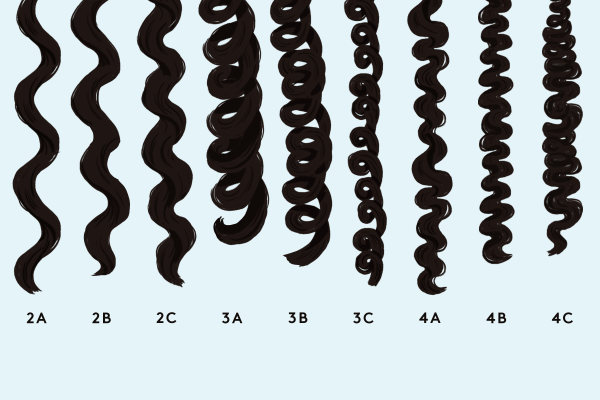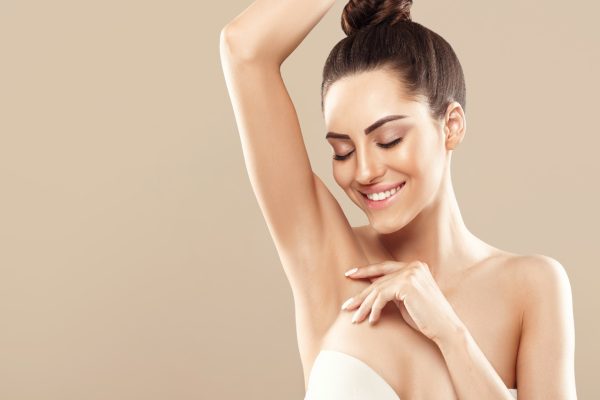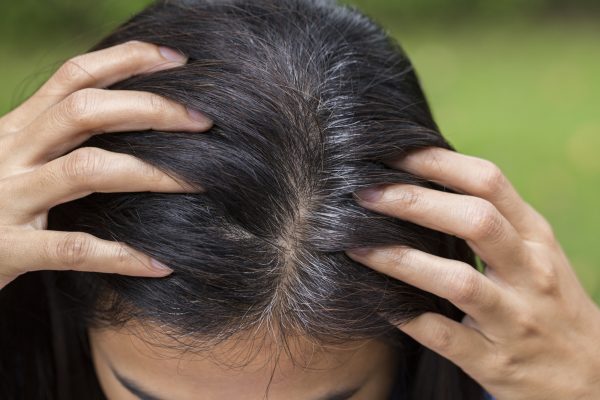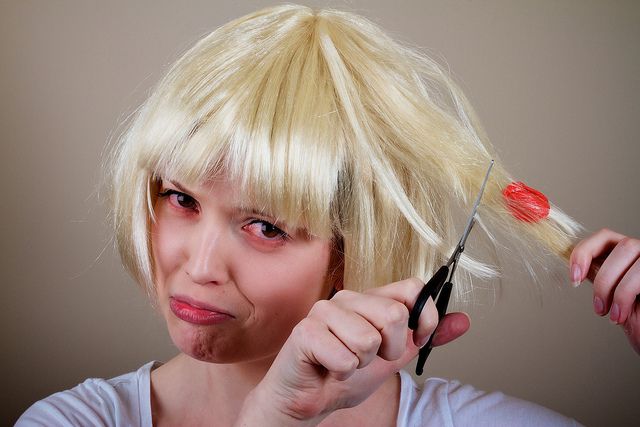We understand. It might be difficult to decode your curl type. Several textures can coexist on one head of curly hair, but they must all appear coherent when styled.
When the strands at your crown are looser than those on the sides, and even more so than those in the back, it’s natural to become frustrated and consider chopping it all off. Which you absolutely can!
But don’t worry if that’s not your thing. Understanding and accepting your texture can be a winding road (because, curls), but it doesn’t have to be unduly difficult.
As of now, most people resort to a specific hair type system for curls developed by hairdresser Andre Walker. We won’t lie: there has been some discussion about whether the typing system is divisive or perhaps overly restrictive.
It’s even gone through several changes over the years, due to the curly community. The people have the upper hand.
Regardless of the controversy, many individuals have discovered that, while not perfect, this specific set of rules may be quite helpful in identifying your curl pattern (or patterns) so you know where to begin when searching for hair-care products.
And, if anything, you should be able to walk into a store with a concept of what you’re looking for to treat your precious crown — as well as some basic understanding of how to manage your hair.
Sure, there’s a lot to consider. Fortunately, we were able to get the help of two industry specialists who are experts in dealing with texture to explain down some of the finer elements of the type categories.
Whether you have smooth bends trickling down your back or tight coils blooming into the skies, there’s a simple method to tell what’s going on up there.
Follow our simple tip sheet below (along with hair-care advice) and you’ll be well on your way to become a curl-typing expert.
Where to Begin?
“The form of the follicle that your hair grows out of from your scalp determines your curl type,” says hairdresser Vernon François.
“The curlier your hair, the flatter or more oval-shaped the follicle; the straighter your hair, the more circular the cross-section. The shape that the strands of hair produce, whether they kink, twist, or coil around themselves into spirals, also identifies your curl pattern.”
Most people with textured hair have more than one pattern on their head, according to François, “so you may have a combination of, say, kinky, coily, wavy, and curly.” Identifying your curl form and pattern(s) is easiest while your hair is damp.

A quick rundown: Type 1 hair is straight, Type 2 hair is wavy, Type 3 hair is curly, and Type 4 hair is coily. Isn’t it simple?
The sub-categories of A through C are determined by the breadth or diameter of your wave, curl, or coil. Type As have a larger pattern size, Type Bs have a medium pattern size, and Type Cs have the smallest of the three.
“The true benefit of knowing your hair type is that you’re better at understanding how to care for your texture, giving you more adaptability,” says Anthony Dickey, the curl guru behind the Hair Rules salon and brand.
Type 2 (Wavy)
Type 2 waves are flexible, have a distinct S pattern that lies closer to the head, and can range in size from fine to coarse.
Type 2A
2A hair has a delicate, barely-there tousled texture that is extremely simple to straighten.
People with this texture should avoid using strong styling products, which may easily weigh down their strands, making them limp and lifeless. If you have this hair texture, be sure the items you’re searching for have a lightweight consistency.
2A waves, like Laura Dern’s, are characterized by a lack of volume at the root. Dickey suggests using an airy, water-based mousse, such as the Aveda Phomollient Styling Foam, to provide oomph at the base of the hair, making it seem fluffier and fuller.
Type 2B
Salma Hayek’s 2B hair is flatter at the crown with pronounced S-shaped waves beginning at the midlength. Strands are thicker in diameter than 2A, so it will take a little more elbow grease to make it straight.
Use a texturizing spray like the Ouai Wave Spray, which is fortified with rice protein for hair that is never crunchy or stiff, to accentuate your natural surfer-babe waves.
Type 2C
2C waves are thicker and more prone to frizz. S-bends are well defined and start at the roots. Shakira is a prime example of this hairstyle. In between washes, apply a non-lathering, sulfate-free co-wash, such as the Briogeo Curl Charisma Rice Amino + Shea Hydrating Co-Wash, to avoid stripping crucial moisture from strands. This product was designed to perform nicely on all curl textures.
Dickey also suggests applying a leave-in conditioner under a mousse to seal in your natural wave pattern while also adding moisture. The Verb Curl Leave In Conditioner and the Design Essentials Natural Almond & Avocado Curl Enhancing Mousse are two of our favorites.
Type 3 (Curly)
Curly hair of type 3 can range from loose, buoyant loops to tight, springy corkscrews with considerable gloss but prone to frizz.
Type 3A
3A strands, like Julia Garner’s, are lustrous and feature huge, loose curls with a diameter around the size of a piece of sidewalk chalk. Scrunch the “SGX NYC Curl Power Nourishing Curl Cream” into your dry hair to enhance the curl texture.
Keep your hands (or brush or comb, for that matter) away from your curls afterward, or you’ll end up with a halo of frizz.
Simply spray your hair with a curl refresher, such as Carol’s Daughter Hair Milk Nourishing & Conditioning Refresher Spray, when it needs a push to keep those luscious springs.
Type 3B
Springy ringlets with the circle of a Sharpie pen characterize 3B kinds like H.E.R. Because this texture might become dry, search for curl gels that contain humectants, which draw moisture to the strands. Mielle Organics Honey & Ginger Styling Gel is a good option. “Apply while [your hair] is damp so you get definition without frizz,” Dickey suggests.
Type 3C
3C curls are tight corkscrews with circumferences ranging from a straw to a pencil, as seen on Nathalie Emmanuel. Strands are closely packed together, allowing for a variety of natural volumes.
Frizziness is prevalent with this kind; if that’s not your style, choose a sulfate-free, creamy cleanser that won’t dry out your hair any more, such the Oyin Handmade Ginger Mint Co-Wash.
When the hair is damp, Dickey recommends stacking a mousse (such as the Best of Beauty-winning Rucker Roots Texture Style Mousse) over a styling cream (such as the Eden BodyWorks Coconut Shea Curl Defining Creme) to allow curls to cluster together and dry faster. “Your co-wash exposes your curl pattern, while your style product catches [it,” Dickey adds.
Type 4 (Coily)
Coily hair, also known as Afro-textured or kinky hair, has a naturally dry and spongy texture that can be silky and fine or harsh and wiry. Strands produce very tight, little zig-zag curls immediately from the scalp and are prone to significant shrinking.
Type 4A
People with hair type 4A have thick, springy, S-patterned coils around the size of a crochet needle. Consider Megan Thee Stallion’s texture.
If you want wash-and-gos, you should style your hair more regularly to keep the coily texture popping with soft, supple strands. A curling cream that contains a leave-in moisturizer is essential for providing moisture to everyday wash-and-go style.
The Hair Guidelines The Hair Rules Kinky Curling Cream Dickey’s go-to cocktail combination is Nourishment Leave-In Moisturizer.
Type 4B
Densely packed 4B strands can bend at severe angles resembling the letter Z. “I like how it can be fashioned in so many various ways,” François explains.
“My Mist Nourishing Water, which is a terrific primer before style in a non-aerosol spray, is one of my favourite products for all kinks, coils, curls, and waves; a little goes a long way and hair appears instantly moisturized.”
Dickey, on the other hand, prefers styling creams for this hair type, such as the Crème of Nature Coconut Milk Curl Hydrating Curling Cream, because they are thicker and great for palm-rolling or shingling, two product distribution methods that stretch out coils and clump them for greater texture definition and elongation.
Type 4C
4C textures are similar to 4B textures, but the tightly coiled strands are more brittle and feature a very tight zig-zag pattern that can be difficult to see.
This hair type sees the most shrinkage — around 75% or more — than the other textures. Take style inspiration from Kiki Layne if you are a 4C. “I adore how adaptable [this texture] is,” François explains.
Because shrinking and dryness are big issues with this type, apply a generous amount of a leave-in moisturizer, such as the SheaMoisture Red Palm Oil & Cocoa Butter Curl Stretch Pudding, to maximize the length of those strands.
We enjoy the SheaMoisture 100% Pure Jamaican Black Castor Oil as a hydrator and sealer for this very dry condition.


